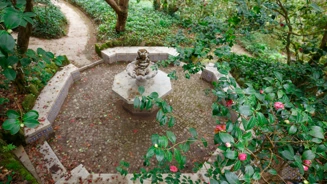
Points of Interest
National Palace of Pena
Camellia Garden

Originally from China and Japan, camellias were introduced to the Park of Pena by King Ferdinand II in 1851. The first specimens were planted on the advice of the French gardener Bonnard who, following a two-day visit to Sintra, selected the most suitable place for the purpose and then sent a load of well-conditioned plants to the Park of Pena from Quinta das Necessidades in Lisbon. The planting was carried out under the guidance of Carlos Ronneberg, the head gardener at the Palace and Park of Pena. The receipts for the purchase of these plants show they were supplied by the most prestigious European nurseries.
The Garden of Camellias features, in addition to international cultivars that were fashionable during the 19th century, many Portuguese cultivars, notably the collection of 18 cultivars of Camellia japonica that represents a genealogical tree of the nation founding House of Bragança, cultivated by Marques Loureiro, a horticulturist from Porto. The collection proved an award winner when picking up the first-class medal in the International Exhibition held in Porto’s Cristal Palace in 1865. To these, others were added, named in homage to various personalities from the 19th century court, the Arts and other events from down the long course of Portuguese history.
Ever since 2009, Parques de Sintra – Monte da Lua, S.A. has advanced with the study, classification and restoration of the extensive camellia collection in the Park of Pena, which includes 3,858 specimens primarily concentrated into four key locations: the Garden of Camellias, the Garden of Queen Amélia, the Garden of the Countess of Edla and the Tea Hill. This inventory included the mapping of the specimens using geographic information systems and the botanical identification of both the different species as well as the respective cultivars featuring in the collection.
Species present in the Park of Pena Camellia Collection
Camellia azalea
Camellia caudata
Camellia cucphuongensis
Camellia edithae
Camellia flavida
Camellia fluviatilis
Camellia forrestii
Camellia granthamiana
Camellia gymnogyna
Camellia huana
Camellia impressinervis
Camellia japonica
Camellia japonica subsp. rusticana
Camellia leptophylla
Camellia liberofilamenta
Camellia longicarpa
Camellia miyagii
Camellia nitidissima
Camellia oleifera
Camellia parvisepala
Camellia petelotii
Camellia polyodonta
Camellia ptilosperma
Camellia pubicosta
Camellia reticulata
Camellia rosaeflora
Camellia rosmanii
Camellia salicifolia
Camellia saluenensis
Camellia sasanqua
Camellia sinensis var. assamica
Camellia sinensis var. sinensis
Camellia taliensis
Camellia transnokoensis
Camellia tsaii
Camellia tsaii var. synaptica
Camellia tunghinensis
Camellia vietnamensis
Camellia virgata
Camellia yuhsienensis





























